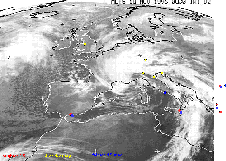How Clear was your Sky? -- Your Observations
The project on light pollution was one of the Collaborative Projects for Astronomy On-Line. A preliminary report has been given by ESO astronomers Richard West and Christian
Drouet-d'Aubigny - thank you very much!
In the meantime I got the time to take a closer look to the data:
Unfortunately the weather during the Astronomy On-Line project was extremely bad in Europe. Till now it was not possible to see Ursa Minor here in Osnabräck!!! And then the moon was waxing and brightening the evening sky so that the limiting magnitude got worse. Nevertheless 25 people sent their reports - many thanks to them all - all are cited below!
Some small results:
- At one city the limiting magnitude can vary much, e.g. in Sofia, Bulgaria, or Giarre, Italy.
Reasons might be:
- Observers with differing observing experience: a more experienced observer might see fainter stars, while a beginner might even misidentify the stars. However it is fascinating to have a limiting magnitude of 5.0 or even 6.3 at a capital!
- Observers might have been not enough dark adapted, e.g. for about 15 minutes.
- The observers might have been at different places of the city: those seeing fainter stars observed at a darker place, while the observer with the bright limiting magnitude was at a well illuminated place. This result experienced the group at Malaga, Spain.
- The moon was already very disturbing as remarked by many participents - often more than artificial lights!
- Unfortunately we can not derive a map of light pollution in Europe as there are too few data. The results projected onto an ESO Meteosat weather image of November 18th (I found none for the hot days) can be seen here: in red are shown places where the faintest stars were 3.5 mag, yellow with limiting magnitude 3.5 - 4.5 mag, and blue with limiting magnitude fainter than 4.5 mag.
 larger image (65k)
larger image (65k)
Some proposals for own projects:
Try to measure the light pollution in your city! This should be a very nice project for school classes as pupils certainly live in different places of the city. Together with some friends (or a local astronomy club) on a clear moonless night, try to determine the limiting magnitude at different places in your city. Will there be a correlation with the city lights? Can you see only bright stars near a brightly illuminated main road? If you have access to astronomical literature: In Sky and Telescope, June 1996, 82, there was a nice report about the project Orion. Several hundred people counted the stars they could see in Orion and by this way the light pollution in Washington, D.C., USA, was determined.
If you have contact to national astronomy associations, try to organize a nationwide project to determine light pollution in measuring the limiting magnitude. Examples are the StarWatch projects in Japan, US, Canada and the Sky Glow Project in UK. Especially for the last example you find a very nice chart of light pollution in the UK - but many people participated!
In measuring the limiting magnitude you can get a feeling for light pollution. Then you can point other people to the problem. By this way you learn to use lamps more efficient and save energy and ... the starry sky!
|
Location
|
Country
|
Latitude
|
Longitude
|
Observer
|
Magnitude
|
|
Sliven
|
Bulgaria
|
42.7 N
|
26.5 E
|
Ivelina Momcheva
|
5.0
|
|
Sofia
|
Bulgaria
|
42.68 N
|
23.5 E
|
Baltova Kremena
|
6.3
|
|
Sofia
|
Bulgaria
|
42.68 N
|
23.5 E
|
Hristo Hristov
|
5.0
|
|
Sofia
|
Bulgaria
|
42.41 N
|
23.5 E
|
Vladimir Georgiev
|
3.0
|
|
Conception
|
Chile
|
36.8 S
|
72 W
|
Juan Seguel
|
5.6
|
|
Munich
|
Germany
|
48.1 N
|
11.6 E
|
Rudolf Brendler
|
3.7
|
|
Bologna
|
Italy
|
44.50 N
|
11.33 E
|
Giada Leoni
|
4.4
|
|
Bologna
|
Italy
|
44.5 N
|
11.3 E
|
Maurizio Casadio
|
4.4
|
|
Bologna
|
Italy
|
44.5 N
|
11.3 E
|
Anna Serra
|
4.4
|
|
Bologna
|
Italy
|
44.5 N
|
11.3 E
|
Cristina Arato
|
4.4
|
|
Giarre
|
Italy
|
37.44 N
|
15.13 E
|
Petralia Placido
|
2.1
|
|
Giarre
|
Italy
|
37.44 N
|
15.13 E
|
Emmanuelle Mangano
|
5.0
|
|
Giarre
|
Italy
|
37.44 N
|
15.13 E
|
Michele Belfiore
|
4.9
|
|
Giarre
|
Italy
|
37.44 N
|
15.13 E
|
Carmelo Adornetto
|
2.1
|
|
Trieste
|
Italy
|
45.5 N
|
13.5 E
|
Conrad Boehm
|
4.2
|
|
Rocca Priora
|
Italy
|
41.47 N
|
12.5 E
|
Marcello Torsoli
|
5.6
|
|
Varedo
|
Italy
|
45.6N
|
9.2E
|
Luca Mauri
|
4.2
|
|
Marousi
|
Greece
|
37.58 N
|
23.43 E
|
Manolis Zoulias
|
3.0
|
|
Thebes
|
Greece
|
38.20 N
|
23.20 E
|
Hatzihronis Epaminondas
|
4.9
|
|
Volos
|
Greece
|
39.33 N
|
23.8 E
|
Kostas Mavrommatis
|
4.4
|
|
Volos
|
Greece
|
39.33 N
|
23.8 E
|
Loukas Zachilas
|
2.1
|
|
Malaga
|
Spain
|
36.7 N
|
4.7 W
|
Belin Martmn-Alarccsn
|
4.9
|
|
Malaga
|
Spain
|
36.7 N
|
4.7 W
|
Josi Dommnguez-Montoya
|
3.0
|
|
Wichita Falls (TX)
|
U.S.A.
|
33.51 N
|
98.29 W
|
Teresa May
|
4.2
|
|
Macclesfield
|
U.K.
|
53.26 N
|
2.1 W
|
Anne Cohen
|
4.4
|
Send comments to Andreas Haenel (Email: ahaenel@rz.uni-osnabrueck.de
and
URL: http://www.physik.Uni-Osnabrueck.DE/students/ahaenel).
Back
 larger image (65k)
larger image (65k)